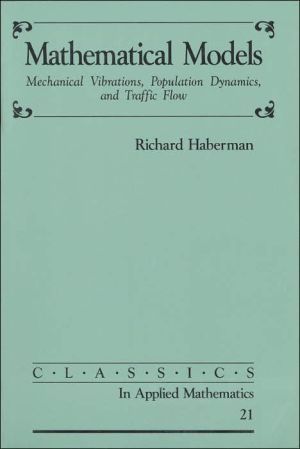

 |

|

Sold Out
Book Categories |
Foreword; Preface to the classics edition; Preface; Part I. Mechanical Vibrations: Introduction to Mathematical Models in the Physical Sciences; Newton's Law; Newton's Law as Applied to a Spring-Mass System; Gravity; Oscillation of a Spring-Mass System; Dimensions and Units; Qualitative and Quantitative Behavior of a Spring-Mass System; Initial Value Problem; A Two-Mass Oscillator; Friction; Oscillations of a Damped System; Underdamped Oscillations; Overdamped and Critically Damped Oscillations; A Pendulum; How Small is Small?; A Dimensionless Time Variable; Nonlinear Frictionless Systems; Linearized Stability Analysis of an Equilibrium Solution; Conservation of Energy; Energy Curves; Phase Plane of a Linear Oscillator; Phase Plane of a Nonlinear Pendulum; Can a Pendulum Stop?; What Happens if a Pendulum is Pushed Too Hard?; Period of a Nonlinear Pendulum; Nonlinear Oscillations with Damping; Equilibrium Positions and Linearized Stability; Nonlinear Pendulum with Damping; Further Readings in Mechanical Vibrations; Part II. Population Dynamics-Mathematical Ecology. Introduction to Mathematical Models in Biology; Population Models; A Discrete One-Species Model; Constant Coefficient First-Order Difference Equations; Exponential Growth; Discrete Once-Species Models with an Age Distribution; Stochastic Birth Processes; Density-Dependent Growth; Phase Plane Solution of the Logistic Equation; Explicit Solution of the Logistic Equation; Growth Models with Time Delays; Linear Constant Coefficient Difference Equations; Destabilizing Influence of Delays; Introduction to Two-Species Models; Phase Plane, Equilibrium, and linearization; System of Two Constant Coefficient First-Order Differential Equations, Stability of Two-Species Equilibrium Populations; Phase Plane of Linear Systems; Predator-Prey Models; Derivation of the Lotka-Volterra Equations; Qualitative Solution of the Lotka- Volterra Equations; Average Populations of Predators and Preys; Man's Influence on Predator-Prey Ecosystems; Limitations of the Lotka-Volterra Equation; Two Competing Species; Further Reading in Mathematical Ecology; Part III. Traffic Flow. Introduction to Traffic Flow; Automobile Velocities and a Velocity Field; Traffic Flow and Traffic Density; Flow Equals Density Times Velocity; Conservation of the Number of Cars; A Velocity-Density Relationship; Experimental Observations; Traffic Flow; Steady-State Car-Following Models; Partial Differential Equations; Linearization; A Linear Partial Differential Equation; Traffic Density Waves; An Interpretation of Traffic Waves; A Nearly Uniform Traffic Flow Example; Nonuniform Traffic - The Method of Characteristics; After a Traffic Light Turns Green; A Linear Velocity-Density Relationship; An Example; Wave Propagation of Automobile Brake Lights; Congestion Ahead; Discontinuous Traffic; Uniform Traffic Stopped by a Red Light; A Stationary Shock Wave; The Earliest Shock; Validity of Linearization; Effect of a Red Light or an Accident; Exits and Entrances; Constantly Entering Cars; A Highway Entrance; Further reading in traffic flow; Index.
Login|Complaints|Blog|Games|Digital Media|Souls|Obituary|Contact Us|FAQ
CAN'T FIND WHAT YOU'RE LOOKING FOR? CLICK HERE!!! X
 You must be logged in to add to WishlistX
 This item is in your Wish ListX
 This item is in your CollectionMathematical models
X
 This Item is in Your InventoryMathematical models
X
 You must be logged in to review the productsX
 X
 X

Add Mathematical models, Mathematics is a grand subject in the way it can be applied to various problems in science and engineering. To use mathematics, one needs to understand the physical context. The author uses mathematical techniques along with observations and experiments t, Mathematical models to the inventory that you are selling on WonderClubX
 X

Add Mathematical models, Mathematics is a grand subject in the way it can be applied to various problems in science and engineering. To use mathematics, one needs to understand the physical context. The author uses mathematical techniques along with observations and experiments t, Mathematical models to your collection on WonderClub |